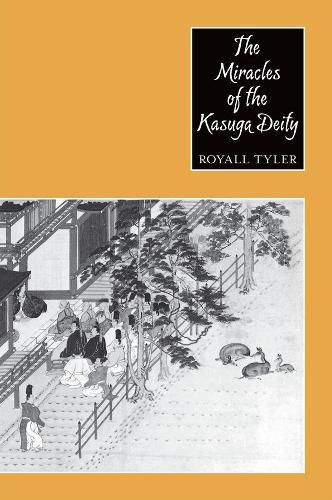Readings Newsletter
Become a Readings Member to make your shopping experience even easier.
Sign in or sign up for free!
You’re not far away from qualifying for FREE standard shipping within Australia
You’ve qualified for FREE standard shipping within Australia
The cart is loading…






In this annotated translation and study of an early fourteenth-century Japanese devotional picture scroll set, Royall Tyler illuminates the complex relationships between medieval Japanese religion and politics, text, and art. The Kasuga Gongen genki ( The Miracles of the Kasuga Deity ) mingles text and painting on silk to tell the tale of miraculous events at the Kasuga shrine in Nara, a site favored by the dominant Fujiwara clan for centuries. The work’s values are aristocratic, but the text sheds light on the syncretic nature of the era’s religious practices, allowing Tyler to collapse the distinction between high and low forms of medieval Japanese religion. Tyler provides a detailed examination of the scrolls, the shrine, and their history and political role. He also elucidates the scrolls’ relationship to literary genre and religious practice, including the interaction between Shintoism and Buddhism. His copious annotations describe the work’s historical context, as well as its religious and cultural influences. This study is essential for scholars of religion, art historians, and cultural historians alike.
$9.00 standard shipping within Australia
FREE standard shipping within Australia for orders over $100.00
Express & International shipping calculated at checkout
In this annotated translation and study of an early fourteenth-century Japanese devotional picture scroll set, Royall Tyler illuminates the complex relationships between medieval Japanese religion and politics, text, and art. The Kasuga Gongen genki ( The Miracles of the Kasuga Deity ) mingles text and painting on silk to tell the tale of miraculous events at the Kasuga shrine in Nara, a site favored by the dominant Fujiwara clan for centuries. The work’s values are aristocratic, but the text sheds light on the syncretic nature of the era’s religious practices, allowing Tyler to collapse the distinction between high and low forms of medieval Japanese religion. Tyler provides a detailed examination of the scrolls, the shrine, and their history and political role. He also elucidates the scrolls’ relationship to literary genre and religious practice, including the interaction between Shintoism and Buddhism. His copious annotations describe the work’s historical context, as well as its religious and cultural influences. This study is essential for scholars of religion, art historians, and cultural historians alike.